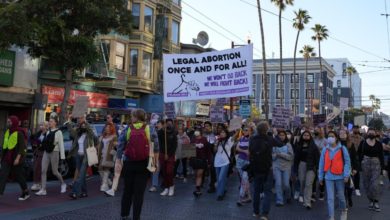Socialist revolution is rightly understood as the process by which the working class overthrows the ruling, exploiting class. But it also unleashes all of society’s contradictions and propels other oppressed groups into motion as part of the social transformation.
In the 20th century, which saw history’s first great socialist revolutions, the struggle for women’s liberation took center stage in the revolutionary process. Because women were often denied the right to a job, health care, reproductive freedom and divorce, while facing severe violence and exploitation in their homes, they had a distinct but clear interest in contributing to revolutionary ideology and action.
Women of the Chinese Revolution
In China, the formation of women’s councils played a key role in spreading the revolution. While the overarching focus of the revolutionary forces was against landlordism, imperialism and the Japanese invasion, the Communist Party’s attention to the special oppression of women highlighted the need to fight for a whole new society: socialism.
The Chinese Red Army helped women form associations to support and educate one another, and to create people’s courts serving women. As landlords were overthrown and oppressors were sent running for the hills, the liberation of women was both a driving force and a growing movement within that revolution.
The Chinese women’s organizations were able to make immediate improvements in the lives of women by organizing against domestic violence. In “Fanshen,” the famous account of a Chinese village newly liberated by the Red Army, William Hinton recounted the militancy with which the women’s committee fought back against abusers: “They rushed at him from all sides, knocked him down, kicked him, tore his clothes, scratched his face, pulled his hair, and pummeled him until he could no longer breathe… They stopped, let him up, and sent him home with a warning—let him so much as lay a finger on his wife again and he would receive more of the same ‘cure’. From that day onward [the abuser] Man-ts’ang never dared beat his wife.”
The All-China Women’s Federation was formed immediately following the success of the 1949 revolution. One of the first major laws passed by the new government was the Marriage Law. This guaranteed a right to divorce and outlawed paying for wives, child marriage, concubines and polygamy. Additionally, campaigns were immediately introduced to increase literacy among women. Just one year after the revolution, 95 percent of China’s illiterate women were in school.
Cuba: The revolution within the revolution
A similar situation played out in Cuba. Prior to the 1959 revolution, women were degraded in the home and at work, denied decent pay, often underfed and disproportionately illiterate. The situation was particularly dismal in smaller villages.
The economy of Cuba, like China, was dominated by imperialism, and this severely affected women. In rural Cuba, peasants suffered from lack of food, education and healthcare. Women and children endured extra hardship. Many women in the cities could only find work as personal servants for the rich or as prostitutes. In the process of the revolutionary struggle, women became a backbone of the urban underground, and rural support to the guerrillas. Women defied the brutal Batista regime to march and demand an end to the repression. Key leaders Vilma Espín, Teté Puebla, Melba Hernández, Haydee Santamaría, Celia Sánchez and others were prominent in the liberation struggle alongside Fidel Castro and the rebels.
After the revolution, the gains made by women needed to be protected and deepened. Revolution is not an overnight process. Despite the overthrow of landlords, U.S. domination and the Cuban bourgeoisie, the influence of the old society lingered in the social division of labor and in working people’s consciousness.
The Women’s Federation of Cuba (FMC) was formed that would advise the government in all matters relevant to women so as to continue the march towards equality and socialism. The FMC encouraged women to come out of their homes and participate fully in the revolutionary process and to learn new skills as workers, while also supporting their social struggle for full equality. Its contributions to subsequent changes in the country include paid maternity leave, severe punishment of violence against women, protection of reproductive and sexual rights, education, social security and the rights to housing and jobs for women.
It is thanks to the socialist government and the FMC that Cuban women have explicit protection in the country’s constitution, and women’s representation in the government is among the highest in the world.
The only solution to oppression
The swift and tremendous gains made in the process and wake of socialist revolutions in these countries prove that socialism and women’s liberation go hand-in-hand. Because gender oppression plays such an important role in capitalism, the active organization of those who suffer from it is crucial to a successful revolutionary process.
History has shown that only socialism has truly protected women’s rights as inalienable and taken on gender equality as a central mission—from the level of the state and through women’s organizations. Only socialism, which empowers poor and working people to transform the economy and society, provides the means to uproot patriarchy and sexism.






